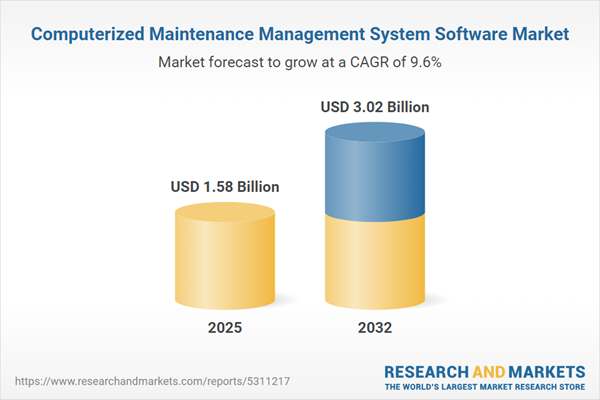Speak directly to the analyst to clarify any post sales queries you may have.
Computerized maintenance management software enables organizations in asset-intensive sectors to optimize critical maintenance processes and support regulatory adherence in increasingly complex operational landscapes. By streamlining asset workflows and reinforcing reliability, CMMS positions senior decision-makers to mitigate risk and deliver durable transformation.
Market Snapshot: Computerized Maintenance Management System Software
The global Computerized Maintenance Management System (CMMS) software market reached a value of USD 1.45 billion in 2024 and is set to grow to USD 1.58 billion by 2025. This expansion is primarily fueled by the accelerating adoption of digital asset management and predictive maintenance strategies across verticals such as manufacturing, transportation, healthcare, utilities, and energy. Organizations are integrating CMMS solutions to capture real-time asset data, automate maintenance workflows, and maximize equipment lifespan. Increasing demand for streamlined, connected processes and scalable cloud-enabled platforms is shaping purchasing priorities. Providers are concentrating on supporting operational excellence and compliance through robust, adaptable systems that align with evolving digital transformation objectives.
Scope & Segmentation of Computerized Maintenance Management Software
- Software Modules: Functions include asset tracking, inventory oversight, maintenance scheduling, facility management, and both predictive and preventive maintenance, each adaptable to specific industry needs.
- Pricing Models: Solutions offer one-time licenses and subscription programs, reflecting varied procurement and investment strategies across enterprises.
- Organization Sizes: Platforms provide flexibility for both global organizations and smaller businesses, enabling controlled scalability and simplified implementation.
- Device and Platform Support: Desktop, web, and mobile accessibility with dedicated iOS and Android capabilities facilitate effective remote and on-site coordination.
- Deployment Modes: Public cloud, private cloud, and on-premise options address organizational preferences in security, compliance, and IT management.
- Industry Verticals: Capabilities are adapted to the requirements of manufacturing, oil and gas, utilities, healthcare, and transportation, supporting industry-specific regulatory and operational objectives.
- Regional Coverage: Adoption encompasses the Americas, Europe, Middle East, Africa, and Asia-Pacific, allowing organizations to address regionally distinct drivers and compliance factors.
- Key Companies Covered: IBM Corporation, SAP SE, Accruent LLC, Cryotos, eMaint Enterprises LLC, Eptura Inc., Fracttal Tech S.L., Honeywell International Inc., IDASA SISTEMAS S.L., IFS AB, JDM Technology Group, Limble Solutions Inc., ManWinWin Software, Mapcon Technologies Inc., MRI Software LLC, NEXGEN Utility Management Inc., Ramco Systems Limited, Rockwell Automation Inc., Schneider Electric SE, Siemens AG, SIERRA ODC Private Limited, Sockeye Technologies Inc., Spacewell International NV, UpKeep Technologies Inc., Oracle Corporation, ABB Ltd.
Key Takeaways for Senior Decision-Makers
- IoT integration with CMMS platforms delivers proactive equipment monitoring, improving maintenance predictability and reducing unplanned downtime risk.
- Artificial intelligence and edge computing streamline maintenance planning, resource allocation, and promote prompt operational response.
- Cloud-enabled CMMS enhances cross-functional collaboration and maintains access consistency as maintenance requirements evolve.
- Modular system designs and ERP integration help reduce deployment risks and enable phased capability expansion.
- Technologies such as digital twins and virtual commissioning strengthen compliance flexibility and help organizations adapt to changing industry landscapes.
- Flexible workflow design allows maintenance processes to align with organization-specific needs or industry drivers.
Tariff Impact on Ecosystem Costs
Adjustments in tariffs affecting essential CMMS hardware, including controllers and sensors, are impacting both procurement and ongoing operational costs within asset-based industries. To better control cost fluctuations, industry leaders are intensifying supply chain management and extending the use of cloud-based deployment. This allows for greater cost predictability and reinforces the importance of evaluating total ownership costs when assessing vendor platforms in volatile economic conditions.
Methodology & Data Sources
This market analysis is based on comprehensive secondary research, direct discussions with established CMMS software providers, and insights from a global community of maintenance professionals. Surveys and expert interviews from across industries enrich the understanding of current adoption patterns and future technology shifts.
Why This Report Matters
- Delivers benchmarks and guidance for executives responsible for digital maintenance programs amid dynamic market conditions.
- Enables procurement and operations leaders to align maintenance technology adoption with broader business goals and risk management priorities.
- Presents practical, unbiased intelligence on current trends, advancements, and actionable best practices to ensure compliance and operational agility.
Conclusion
Computerized maintenance management software continues to underpin operational resilience and modernization. Senior leaders and their teams can utilize these strategic insights to future-proof maintenance models and sustain high-performance operations.
Additional Product Information:
- Purchase of this report includes 1 year online access with quarterly updates.
- This report can be updated on request. Please contact our Customer Experience team using the Ask a Question widget on our website.
Table of Contents
3. Executive Summary
4. Market Overview
7. Cumulative Impact of Artificial Intelligence 2025
Companies Mentioned
The companies profiled in this Computerized Maintenance Management System Software market report include:- International Business Machines Corporation
- SAP SE
- Accruent, LLC
- Cryotos
- eMaint Enterprises LLC
- Eptura, Inc.
- Fracttal Tech S.L
- Honeywell International Inc.
- IDASA SISTEMAS S.L.
- IFS AB
- JDM Technology Group
- Limble Solutions, Inc.
- ManWinWin Software
- Mapcon Technologies, Inc.
- MRI Software, LLC
- NEXGEN Utility Management Inc.
- Ramco Systems Limited
- Rockwell Automation, Inc.
- Schneider Electric SE
- Siemens AG
- SIERRA ODC Private Limited
- Sockeye Technologies Inc.
- Spacewell International NV
- UpKeep Technologies, Inc.
- Oracle Corporation
- ABB Ltd
Table Information
| Report Attribute | Details |
|---|---|
| No. of Pages | 184 |
| Published | October 2025 |
| Forecast Period | 2025 - 2032 |
| Estimated Market Value ( USD | $ 1.58 Billion |
| Forecasted Market Value ( USD | $ 3.02 Billion |
| Compound Annual Growth Rate | 9.6% |
| Regions Covered | Global |
| No. of Companies Mentioned | 26 |









